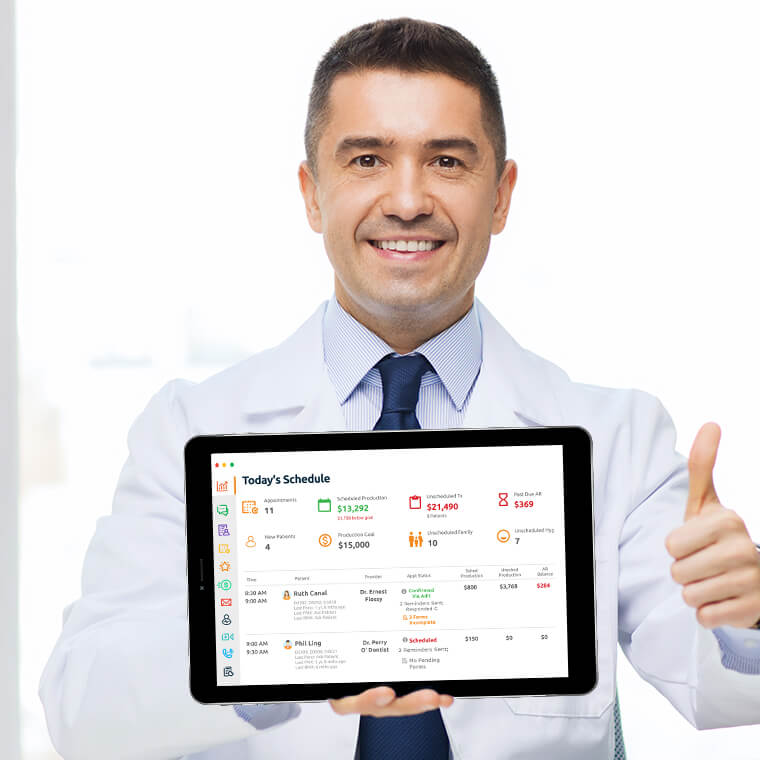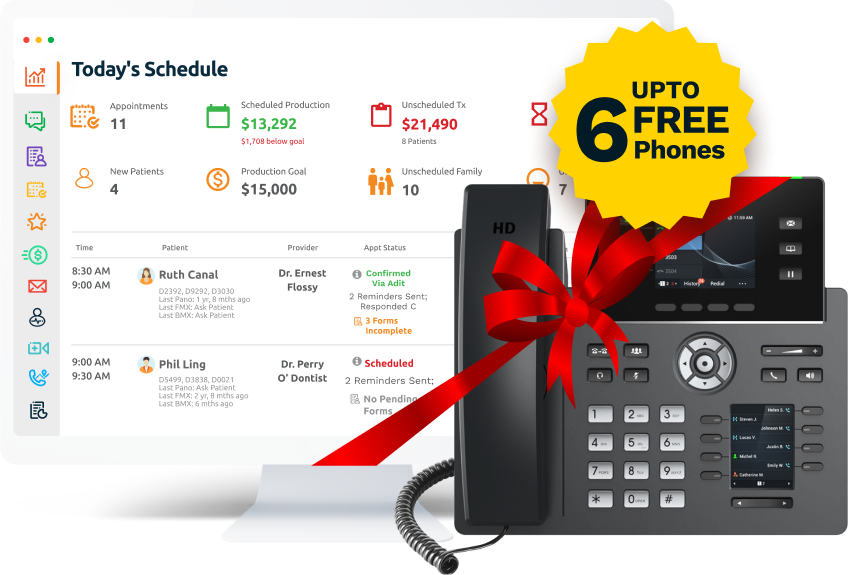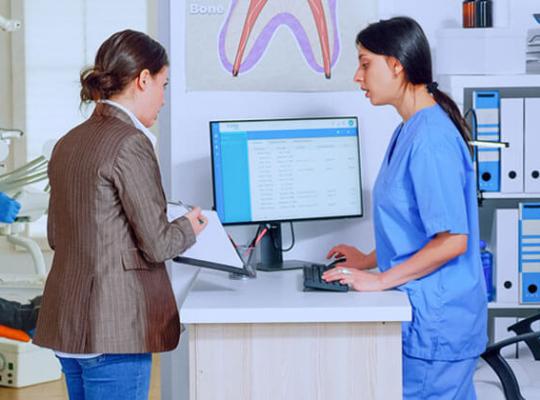Ends in
ends in 127 Days

ends in 127 Days

ends 11 July
Must-Have Dental Software Features in 2024

The incorporation of cutting-edge technology has become a cornerstone for dental providers wanting to deliver superior patient care and optimize their practice management strategies. Today, dental offices are increasingly reliant on sophisticated dental software to meet the multifaceted challenges of modern dentistry. If you're looking for new software or are interested in the latest integrations to enhance your clinic's operations, you will love the must-haves we have shared in this article.
Keep reading to discover how these features not only meet industry demands but also enhance the overall experience for both dental practitioners and their patients.
Integrated Electronic Health Records (EHR)

In 2024, the integration of Electronic Health Records (EHR) into dental software continues to be a pivotal aspect of practice management. While the concept of EHR itself is not new, how dental software leverages and integrates these records has evolved significantly. Dental practitioners are increasingly recognizing the importance of a comprehensive records system within their software to provide a holistic view of patients' medical histories, treatment plans, and overall health.
Dental software needs to adapt to the specific needs of dental professionals due to the unique challenges of oral healthcare. Integrating EHR goes beyond just digitizing; it strategically streamlines workflows, improves accuracy, and promotes a patient-focused approach to dental care. Instead of cumbersome paper-based files and space-eating cabinetry, dental software can store everything securely in the cloud, creating a virtually paperless office environment.
Additionally, even EHR integrations into existing dental software align with the wider trend of healthcare interoperability. Recognizing the interconnected nature of overall health, dental software seamlessly connects with broader healthcare systems. This enables secure and efficient information exchange among multiple medical disciplines, providing dental practitioners with complete patient medical histories for more informed decision-making and collaborative healthcare practices.
Telehealth Capabilities

In the post-COVID era, telehealth has become a cornerstone of dental care, profoundly impacting patient satisfaction and daily operations while bolstering cash flow. Dental software seamlessly integrates virtual consult features, making care more accessible and convenient for patients. This not only reduces wait times but also ensures prompt consultations, elevating overall patient satisfaction.
Operationally, telehealth streamlines scheduling, eliminates paperwork burdens, and fosters efficient team collaboration. These improvements optimize daily workflows, allowing for better resource utilization and a more coordinated approach to patient care.
From a financial standpoint, telehealth expands the patient reach, attracting individuals who may have been deterred by distance or time constraints. Additionally, optimized appointment utilization and streamlined billing processes contribute to a steady and enhanced cash flow for dental practices.
AI-Powered Practice Analytics
In 2024, dental software goes beyond simple diagnostics, incorporating Key Performance Indicators (KPIs) tracking capabilities.
How does this work? AI algorithms analyze patient data to assist dental teams in optimizing scheduling, minimizing wait times, and enhancing operational efficiency. This contributes to practice sustainability by streamlining processes and reducing overhead costs. However, AI-driven practice analytics extends beyond just tracking treatment outcomes and tailoring interventions:
Appointment Turnaround Time
Efficiently managed scheduling through AI algorithms significantly reduces the time from appointment booking to actual visits. This not only optimizes resource utilization but also ensures that patients receive prompt care, contributing to overall practice efficiency.
Wait Time Reduction
By leveraging AI-optimized scheduling, practices witness a notable reduction in patient wait times. This improvement enhances the patient experience, showcasing a commitment to timely and accessible care.
When Weave dropped their calls, Adit answered Manual processes. Unreliable systems. Sound familiar? This practice was juggling too many tech issues behind the scenes. Then they found Adit. Read how they traded system crashes and paperwork chaos...
Schedule a DemoOperational Costs vs Revenue
The implementation of AI-driven treatment planning is reflected in the balance between operational costs and revenue. Dentists can assess the financial impact, ensuring that the practice remains sustainable and financially viable.
Treatment Success Rates
AI's analysis of historical data allows practices to track the success rates of various treatments. This not only enhances patient outcomes but also builds confidence in the effectiveness of the provided dental care.
Patient Satisfaction Scores
Through AI-driven patient feedback analysis, dentists gain insights into patient satisfaction levels. Focusing on areas highlighted by AI enhances patient contentment, contributing to a positive practice reputation.
Online Reviews and Ratings
Improvements in online reviews and community reputation are observable outcomes of AI-enhanced patient satisfaction initiatives. Positive online feedback strengthens the practice's online presence and attracts more patients.
Engagement Rates with Automated Feedback Systems
The implementation of link-embedded SMS messaging for automated feedback systems increases patient engagement. This convenient communication method fosters a more interactive patient-practitioner relationship, encouraging patients to provide valuable feedback.
Timeliness of Care Delivery
AI-assisted treatment planning ensures timely care for patients, reducing bottlenecks in the scheduling process and contributing to the overall efficiency of the practice. This emphasis on timely care aligns with a patient-centric approach, enhancing the overall quality of service.
These are just a few of several important KPIs that highlight the tangible benefits of AI-powered treatment planning, showcasing its positive impact on both practice management and patient care. By focusing on effective treatments, practices not only enhance patient outcomes but also build trust and satisfaction.
Automation of Administrative Tasks

Efficient practice management is paramount for dental practices, and in 2024, the automation of administrative tasks through dental software will be integral. Automation has quickly become a must-have that not only saves time but ensures a streamlined workflow within the practice.
Time-Saving Automation
Modern dental software automates administrative tasks like appointment scheduling, billing, and insurance claims processing, saving significant time for dental professionals. Platforms like Adit can help offices reclaim an average of 15 hours of lost productivity time per week by automating mundane tasks.
Enhanced Productivity
Leveraging dental software allows practitioners to redirect their focus from manual processes to quality patient care, contributing to improved overall practice efficiency by removing bottlenecks and balancing task load.
Reduced Errors
Automation in administrative processes helps in reducing human errors, ensuring the accuracy and reliability of tasks, and minimizing the risk of delays or financial discrepancies.
Patient-Centric Benefits
Streamlined scheduling, made possible through real-time online booking integrations, enhances accessibility for patients, while automated billing promotes efficient financial transactions, positively impacting the patient experience.
Digital Communication Facilitation
Dental practices adopting automation in administrative tasks facilitate seamless patient engagement through digital communication. Automated reminders via secure 2-way patient SMS, for instance, not only reduce no-shows but also add convenience to everyday communication, fostering a patient-centric approach.
Improved Patient Connection
The positive impact of administrative task automation extends to patient engagement, creating a connected and well-informed patient base. Automated recall and email marketing campaigns can be easily personalized to address care concerns relevant to the recipient which contributes to a patient-centric experience.
Enhanced Imaging and Diagnostic Tools

Another important must-have feature your dental software needs in 2024 is the incorporation of advanced imaging and diagnostic tools. While the upfront costs may be significant, these technologies serve as invaluable assets for future-proofing dental offices, offering benefits that extend far beyond the initial investment.
- 3D Imaging
- Intraoral Cameras
- AI-Powered Image Analysis
- Digital Radiography
- Innovative Imaging Modalities
- Integrated Imaging Software
- Teledentistry Imaging
By investing in technology capable of capturing high-resolution images and leveraging AI algorithms for in-depth analysis, dental practitioners can tailor treatments with an unprecedented level of precision. This not only improves treatment outcomes and reduces procedural times but also positions dental practices at the forefront of technological advancements in oral healthcare.
As we look ahead, the future of digital technology in dentistry holds the promise of even more innovative tools and seamless integration, shaping an era where precision, efficiency, and patient-centric care converge for sustained success in dental practices.
Patient Engagement and Communication Tools

The pivotal role of patient engagement and communication tools and features within dental software extends beyond mere convenience, transforming into a cornerstone for practice efficiency and elevated patient care experiences. Bringing these moving elements under a singular, cohesive umbrella will amplify patient engagement and nurture team collaboration, fostering a holistic and streamlined approach to dental care.
Automated communication via email, text, and patient portals has become indispensable in modern dentistry for a variety of reasons, including:
- No-Show Reduction: Automated reminders significantly reduce no-shows, ensuring a higher rate of appointment adherence.
- Centralized Communication: Dental software acts as a unifying element, maintaining synchronized communication between patients and the dental team using a centralized approach.
- Efficiency Enhancement: Centralized communication enhances operational efficiency and minimizes the risk of information gaps within the practice.
- Secure Messaging Features: Secure SMS text features provide a platform for direct and secure communication between practitioners and patients, eliminating the need for fragmented communication methods.
Without a doubt, the integration of patient engagement and communication tools redefines the landscape of dental practice management. Beyond their individual functionalities, these tools collectively establish a strategic and interconnected framework that enhances patient engagement and positions offices at the forefront of efficient and patient-centric care in 2024.
Security and Compliance Measures

In 2024, the imperative for robust security and compliance measures in dental practices is underscored by real-world incidents of data breaches and cyber threats within the industry. There are countless examples highlighting the critical need for dental software to prioritize features such as encryption, access controls, and regular updates, aligning with governing legislation like the Health Insurance Portability and Accountability Act (HIPAA).
North American Dental Management recently experienced a data breach, impacting thousands of patients across multiple dental practices utilizing its services. The breach compromised not only medical records but also financial information, triggering a chain reaction of identity theft and financial fraud. This attack underscores the steep cost dental organizations may face if their patient data becomes compromised.
In the face of a substantial increase in data breaches affecting dental practices, safeguarding consumer data has become paramount. The reported surge of 45% in data breaches over the last two years, with an average cost of $9.23 million, underscores the urgency for robust security measures. In this context, the features embedded in dental software assume a critical role in fortifying the protection of consumer data. Advanced security protocols within dental software, including encryption, access controls, and regular security updates, are imperative to thwart potential cyber threats.
As dental practices navigate an evolving digital landscape, prioritizing software features that prioritize the security and privacy of patient information becomes not only a prudent measure but an ethical obligation. By investing in dental software with robust security features, practices can not only enhance operational efficiency but also establish trust and confidence among patients, fostering a secure environment for the management of sensitive healthcare data.
Choosing Dental Software: A Simple Guide

Selecting the right dental software or upgraded integrations is crucial for running a smooth and effective practice. Modern dental software offers advanced features that can improve diagnosis, streamline tasks, and enhance patient care. From understanding what your practice requires to checking security measures and exploring new technologies, each step in this overview can help you make the right decision for your dental office.
1. Assess Practice Needs
Begin by identifying the specific needs and challenges of your dental practice. Consider aspects such as appointment scheduling, billing, imaging, and patient communication. Understanding your unique requirements will guide your selection process.
2. Evaluate Integration Capabilities
Opt for dental software that seamlessly integrates with other systems and technologies used in your practice, such as electronic health records (EHR), imaging devices, or third-party applications. Integration enhances workflow efficiency and data accuracy.
3. Prioritize User-Friendly Interfaces
Choose software with intuitive and user-friendly interfaces. A system that is easy to navigate and requires minimal training ensures a smoother transition for your team, minimizing disruptions to daily operations.
4. Ensure Compliance with Regulations
Verify that the dental software complies with industry regulations, particularly the Health Insurance Portability and Accountability Act (HIPAA) for patient data protection. This ensures that your practice remains legally and ethically aligned with privacy standards.
5. Explore Imaging and Diagnostic Features
Modernized software should offer advanced imaging and diagnostic tools, such as 3D imaging, intraoral cameras, automatic EHR updating, and AI-powered analysis. These features contribute to more accurate diagnostics and enhanced treatment planning.
6. Check Security Measures
Prioritize security features, including robust encryption, access controls, and regular software updates. Recent incidents highlight the importance of safeguarding patient data against cyber threats, making security a non-negotiable aspect of modern dental software.
7. Assess Cloud-Based Options
Consider cloud-based dental software for enhanced accessibility and flexibility. Cloud solutions allow secure access to patient information from various locations, fostering collaboration and ensuring continuity of care.
8. Review Vendor Reputation
Research the reputation of the software vendor. Read customer reviews, testimonials, and case studies. A vendor with a positive track record is more likely to provide reliable support and ongoing updates.
9. Request Demos and Trials
Before making a final decision, request demonstrations and trial periods for shortlisted dental software. This hands-on experience allows your team to assess the software's functionality, ease of use, and compatibility with your workflow.
10. Consider Long-Term Scalability
Choose dental software or integrated features that align with your practice's long-term goals and scalability. Consider future growth, additional features, and the ability of the software to adapt to evolving technological trends within the dental industry.
By following this step-by-step guide, you can make an informed decision when choosing comprehensive dental software like Adit that not only meets your current needs but also positions your practice for success in the evolving landscape of dental care.
Ignite Your Dental Practice with Adit Software

Throughout this journey, envision a practice where routine tasks are streamlined, patient interactions are elevated, and your team operates with heightened precision. Adit dental software stands not just as a technological solution but as a strategic partner committed to mastering the unique dynamics of your practice.
With over 15+ digital management tools at your disposal, it's never been easier to take your practice to new heights of service, reputation, and profitability in 2024:
- Online Scheduling
- Patient Forms
- Seamless EHR Integration
- Adit Pay
- Telemed
- Adit Voice
- Mobile App
- Treatment Planning
- Practice Analytics
- Call Tracking
- Patient Recall
- Automated Reminders
- Pozative Reviews
- Email Marketing
- eFax
- And so much more!
Your patients deserve the best, and Adit delivers nothing less. Why do our clients trust us to help them achieve success?
Seamless Integration: Adit Software seamlessly integrates into your practice, ensuring a smooth transition for your team.
Unwavering Security: Your patient data is safeguarded with robust encryption, stringent access controls, and regular updates, protecting against cyber threats.
Efficiency Redefined: Imagine a world where administrative tasks are a breeze, patient engagement soars, and your team operates at peak efficiency.
Sustainability in Practice: With Adit, sustainability isn't just a buzzword; it's an integral part of your practice's future, ensuring long-term viability and success.
Continuous Innovation: With Adit, your office will always be at the forefront of practice management technology using the latest and greatest digital tools we develop just for dental professionals like you.
Book a demo today to experience firsthand how Adit dental software sparks a transformation in your practice, transforming it into a beacon of excellence.
more about Adit?
Access a full suite of patient communication tools with Adit! Texting, payments, reviews, & scheduling in one place.
Schedule a DemoAngela is a former English teacher turned marketing content specialist. Over the past 10 years, she’s developed marketing strategies to forge enduring bonds between B2B, B2C and SaaS companies and their clients through holistic education, effective communication, and captivating storytelling that moves audiences to act.
Get a $25 Gift Card when you take a demo
Schedule a Demo
Get a $50 Gift Card
when you take a demo
Looks like you're out of bounds!
Hey there! Your current location falls outside Adit's area of operation. If this is unexpected, try disabling your VPN and refresh your page. For further assistance or to book a live demo, connect with us at 832-225-8865.
January 7 Amazon Demo Promo
Terms and Conditions
Last Updated: January 7, 2026Offer ends January 10, 2026, and is limited to prospective customers who sign an annual agreement before January 31, 2026. Gift card will be emailed to the company owner or established representative within 4 weeks of signing the annual agreement. Offer may not be combined with any other offers and is limited to one (1) gift card per office. Offer is not available to current customers or to prospective customers or individuals that have participated in a Adit demo during the prior six (6) months. Recipient is responsible for all taxes and fees associated with receipt and/or use of the gift card as well as reporting the receipt of the gift card as required under applicable federal and state laws. Adit is not responsible for and will not replace the gift card if it is lost or damaged, is not used within any applicable timeframe, or is misused by the recipient. Adit is not responsible for any injury or damage to persons or property which may be caused, directly or indirectly, in whole or in part, from the recipient’s participation in the promotion or receipt or use of the gift card. Recipient agrees to indemnify, defend and hold harmless Adit from and against any and all claims, expenses, and liabilities (including reasonable attorney’s fees) arising out of or relating to a recipient’s participation in the promotion and/or recipient’s acceptance, use or misuse of the gift card. This offer is sponsored by Adit Communications, Inc. and is in no way sponsored, endorsed or administered by, or associated with Amazon.
Thank You!
We appreciate your interest! Adit AI will be calling you in the next few minutes!
Why Adit?
Cut your software bill by up to 60% when you merge everything your dental office needs to run under one roof.
Centralize Communications
- Phones & TeleMed
- Emails & eFax
- Texting & Reminders
- Call Tracking and more!
Streamline Operations
- Patient Forms
- Online Scheduling
- Payments
- Reviews and more!
Boost Production
- Performance Dashboards
- Morning Huddle
- Claims & Collections
- Patient Profiles
- Follow Up Lists
- Year Over Year Metrics
Acquire More Patients
- Digital Marketing
- Website Design
- SEO
- Google Ads
- Facebook Ads
Ends in

and Get Free Phones for Life
Sign up by filling out the form







